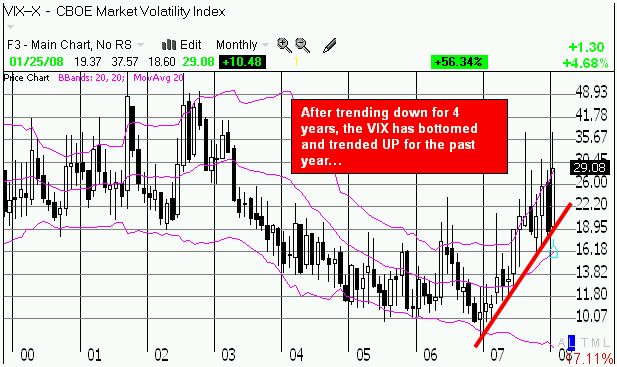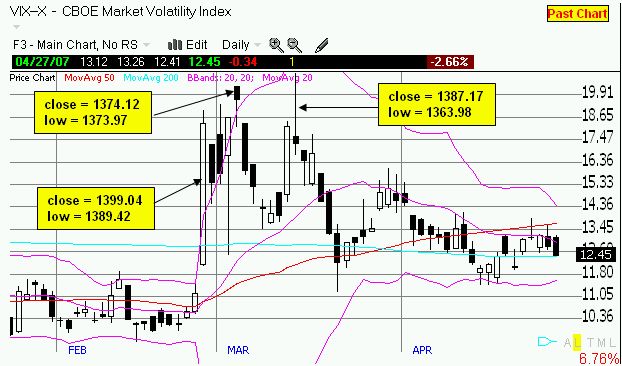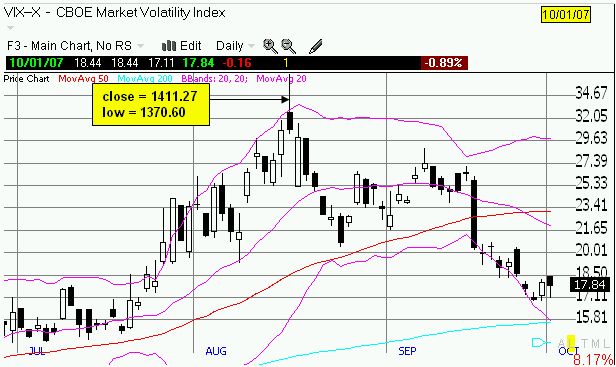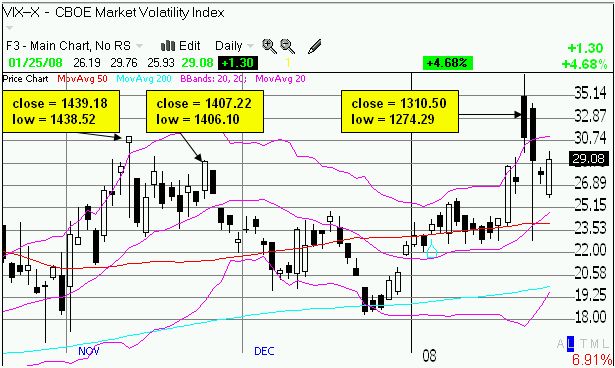A lot of traders use volatility indices as indicators of market bottoms. When volatility spikes, fear, and then selling, reach a climax. Given last week's "black swan" event that appeared to generate a climax to 2008's non-stop selling, I thought I would take an updated look at the VIX, the CBOE's market volatility index.
First, a quick reminder on the context. It's easy to assume that we have identified the culprit to the selling - the rogue trader who lost $7B for Societe Generale. Last week's trading even ended with gains on the S&P 500 and flatline for the NASDAQ. However, the selling had entered a third week amidst growing recession fears. These fears have been all but validated by the Fed's rush to slash interest rates and the Federal government's scramble to rescue the economy. On the other hand, we have several big and important companies - like Intel (INTC), Caterpillar (CAT), Nokia (NOK), and others - who have looked into the abyss and see nothing wrong with the global growth story. Sure, many companies have confirmed that the U.S. is sputtering, but global growth continues unabated and unconcerned. So, I strongly suspect (the fear of) a recession has not yet been fully priced into the market. The year-long uptrend on the VIX seems to tell us to expect even more wild days and even lower prices ahead.

When zooming in on the VIX over the last 4 selling spasms, I think there are three primary lessons for the past year (charts below):
- We see confirmation that some kind of near-term bottoming process occurs in the S&P 500 when the VIX spikes. No surprise there. (I did not juxtapose the S&P and instead label the spikes with the S&P's price at the given time).
- One spike is not sufficient to mark a bottom. That is, the appearance of a spike in volatility does not prevent another spike from occurring shortly thereafter. The March low came after three spikes in volatility occurred in the span of less than three weeks.
- The absolute low does not need to occur on the highest spike in volatility during the bottoming process. This is what happened in November.
(The yellow labels on the chartsshow the close and the low of the S&P500 during spikes in volatility).



Overall, traders who automatically bought upon witnessing spikes in volatility have been generally rewarded within three to four weeks - especially if they held on long enough and not a moment more. Since we have now crashed through the 2007 lows, we should understand that a volatility spike is not sufficient to print a longer-term bottom. More disturbing for the bulls is that last week's spike essentially matched August's spike and yet the S&P hit a low 100 points below August's (about 7% lower). This suggests that an even larger spike in volatility is probably on its way soon. And even if it does not occur soon, the VIX appears to be on an uptrend (as shown earlier). That is, risks are increasing and NOT decreasing as many would optimistically suggest after observing another automatic bounce in prices from a volatility spike.
I pointed out last year that it seemed the three or four-year decline in volatility had come to an end. I think the swells of selling over the past 12 months confirm this observation. The VIX is now penetrating levels last seen in the first years of this decade. I am guessing those levels will prove to be quite "sticky" again.
Lastly, I will return to my "finger in the air" target low of 1200 for the S&P 500. I wrote that before the drama of last week. But once the drama was underway, it sure looked like my target would bumrush the scene much earlier than I could have feared! Anyway, another thought hit me that seems to add credence to my earlier reasoning. Take a look at Countrywide Financial (CFC). CEO Angelo Mozilo spent most of 2006 and 2007 comforting us that his company was fine. He even spent time sifting through the bargain bins of his newly bankrupt competitors. But now Bank of America (BAC) is buying CFC from the bargain bin! Since I will not call him a liar, I will assume that Mozilo kept underestimating just how bad things were getting. Similarly, the executives of IndyMac Bancorp Inc. (IMB) not only insisted all was fine as late as last March, but executives also loaded up on the stock to prove their conviction. For a while, I tried to hang with them, but I could not. The stock has since lost about 80% of its value. We have seen this knack for underestimating our woes repeated from the rating agencies to the regulators to the boardrooms. (It is sadly reminiscent of the way technology executives downplayed the looming bust of the tech bubble and even its aftermath until they were absolutely forced to the wall with stock values slashed 50% and more). Under these conditions why should we rest assured we have seen THE bottom anytime volatility spikes? I know I got caught up back in November for a hairbrained moment. Just food for thought...
Be careful out there!